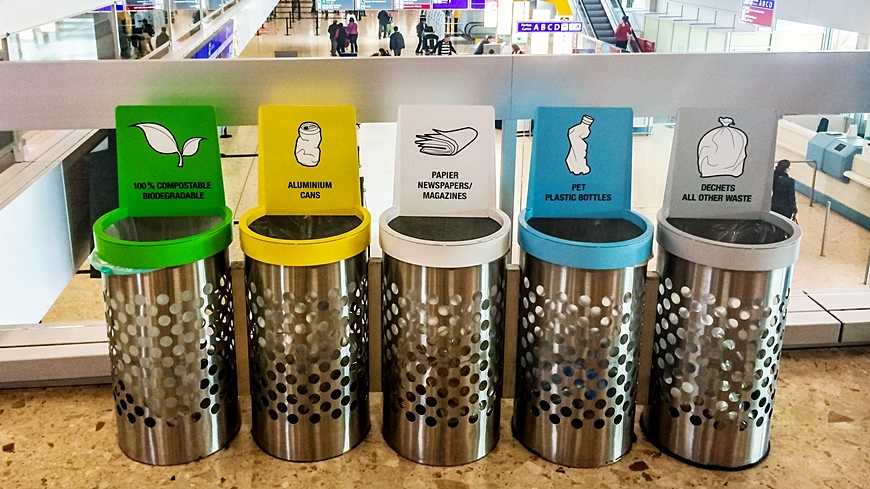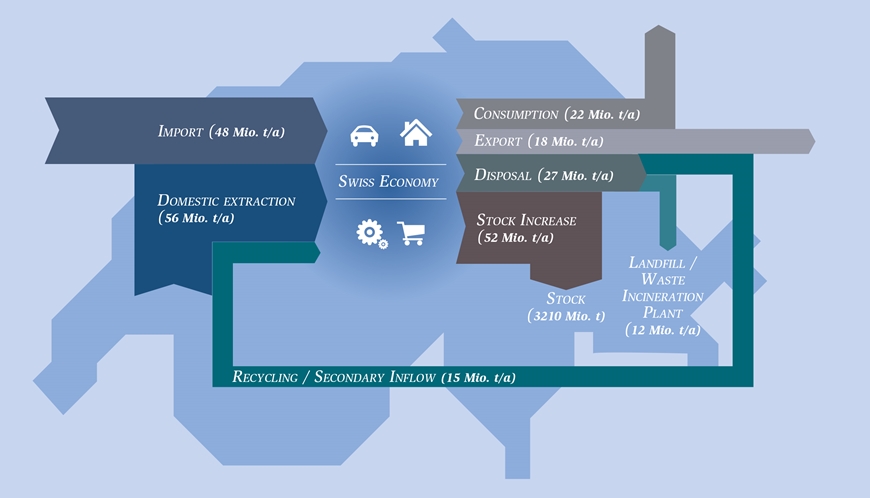How much does Switzerland consume?
87 million tons of material each year
Empa researchers have analyzed the entire material and energy flows of the Swiss economy. Their final report now provides important data and comparisons. The team also looked into how the behavior of the Swiss population affects greenhouse gas emissions.

Operating masses for an entire country
This data mosaic is now summarized in the fourth part: a synthesis report as a snapshot of the mass and energy flows for the year 2018. Some key figures thereof: The domestic material consumption amounts to 87 million tons net per year: the necessary mass to keep the Swiss economy running. Examples of outflowing masses: 12 million tons ended up in final disposal; exports amounted to 18 million tons.
A large part of the inflowing material remains in the system – and allows Switzerland's material stock to grow. Overall, it increases by 1.6 percent per year – as of 2018 – or by 52 million tons. The total weight of Switzerland's material stock: around 3.2 billion tons.

Data from many sources
To be able to determine such data, the Empa team evaluated numerous sources. In the "Mobility" category, the Federal Statistical Office, among others, provided useful information; for "Consumption and Production", data from the Federal Customs Administration was helpful. And for the built inventory, including buildings and traffic routes, the experts drew on earlier studies. On balance, according to the Empa researchers, these data ensured a good approximation to reality, even if they do not replace the official statistical data from federal authorities.
In the construction sector, the current consumption figures are also interesting: Almost half of the used material is concrete – just under 40 million tons annually. The entire construction sector amounts to 62 million tons, while the production and consumption sector consumes just under 18 million tons: one fifth of the total mass consumed.
In terms of environmental impact, the study focuses in particular on greenhouse gas emissions. The most prominent source of greenhouse gases is fuel consumption, with just under 25 million tons, a share of around a quarter of annual emissions. It is followed by fuels (just under 20 percent), food (more than 18 percent), electricity (just under 6 percent) and steel (just under 5 percent). However, textiles and leather, as well as basic chemicals, also make a notable contribution at 4.5 percent each.
The influence of personal lifestyle
A special feature of the study is the differentiated consideration of the influence of the Swiss population. In addition to per capita consumption data, the researchers analyzed the impact of personal scope for action on climate protection: If all Swiss behaved like the fifth of the population with the most exemplary lifestyle, Switzerland's total greenhouse gas emissions could be reduced by 16 percent. If, on the other hand, everyone behaved like the fifth with the least ecological lifestyle, emissions would increase by 17 percent.
A synthesis of three extensive studies
28 consumption areas were differentiated and 18 material categories defined, including solid materials such as mineral raw materials, metals, plastics, but also food as well as fuels, motor fuels and electricity. The natural resource water was not included.
The cross-border and Switzerland-internal mass flows were expressed as "domestic material consumption". Environmental impacts were calculated using a simplified life cycle assessment approach, which is explained in the final report.
Dr. Cecilia Matasci
Technology and Society
Phone +41 58 765 71 73
Marcel Gauch
Technology and Society
Phone +41 58 765 78 54
Norbert Raabe
Communication
Phone +41 58 765 44 54
redaktion@empa.ch
The final synthesis report can be found here (in german language).
Scientific Publication: C Matasci, M Gauch, H Böni, P Wäger; The influence of consumer behavior on climate change: the case of Switzerland; Sustainability (2021); doi.org/10.3390/su13052966
-
Share






